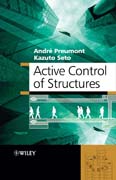
With "Active Control of Structures", two global pioneers present the state-of-the-art in the theory, design and application of active vibration control. Asthe demand for high performance structural systems increases, so will the demand for information and innovation in structural vibration control; this book provides an effective treatise of the subject that will meet this requirement.The authors introduce active vibration control through the use of smart materials and structures, semi-active control devices and a variety of feedback options; they then discuss topics including methods and devices in civil structures, modal analysis, active control of high-rise buildings and bridge towers, active tendon control of cable structures, and active and semi-active isolationin mechanical structures."Active Control of Structures" discusses new types of vibration control methods and devices, including the newly developed reduced-order physical modelling method for structural control. It introduces triple high-rise buildings connected by active control bridges as devised by Professor Seto. It offers a design strategy from modelling to controller design for flexible structures. It makes prolific use of practical examples and figures to describe the topics and technology in an intelligible manner. INDICE: About the Authors.Preface.Acknowledgements.1 Active Damping.1.1 Introduction.1.2 Structural Control. 1.3 Plant Description.1.4 Equations of Structural Dynamics.1.5 Collocated Control System.1.6 Active Damping with Collocated System.1.7 Decentralized Control with Collocated Pairs.2 Active Isolation. 2.1 Introduction.2.2 Relaxation Isolator.2.3 Sky-hook Damper.2.4 Force Feedback.2.5 Six-Axis Isolator.2.6 Vehicle Active Suspension.2.7 Semi-Active Suspension.3 A Comparison of Passive, Active and Hybrid Control.3.1 Introduction.3.2 System Description.3.3 The Dynamic Vibration Absorber.3.4 Active Mass Damper.3.5 Hybrid Control.3.6 Shear Control.3.7 Force Actuator, Displacement Sensor.3.8Displacement Actuator, Force Sensor.4 Vibration Control Methods and Devices.4.1 Introduction.4.2 Classification of Vibration Control Methods.4.3 Construction of Active Dynamic Absorber. 4.4 Control Devices forWind Excitation Control in Civil Structures.4.5 Real Towers Using the Connected Control Method.4.6 Application of Active Dynamic Absorber for Controlling Vibration of Single-d.o.f.Systems.4.7 Remarks.5 Reduced-Order Model for Structural Control.5.1 Introduction.5.2 Modeling of Distributed Structures.5.3 Spillover.5.4 The Lumped Modeling Method.5.5 Method of Equivalent Mass Estimation.5.6 Modeling of Tower-likeStructure.5.7 Modeling of Plate Structures. 5.8 Modeling of a Bridge Tower.5.9 Robust Vibration Control for Neglected Higher Modes.5.10 Conclusions.6 Active Control of Civil Structures.6.1 Introduction.6.2 Classification of Structural Control for Buildings.6.3 Modeling and Vibration Control for Tower Structures.6.4 Active Vibration Control of Multiple Buildings Connected with Active Control Bridges in Response to Large Earthquakes.6.5 Vibration Control for Real Triple Towers Using CCM.6.6 Vibration Control of Bridge Towers Using a Lumped Modeling Approach.6.7 Conclusion. References.Index.
- ISBN: 978-0-470-03393-7
- Editorial: John Wiley & Sons
- Encuadernacion: Cartoné
- Páginas: 296
- Fecha Publicación: 24/10/2008
- Nº Volúmenes: 1
- Idioma: Inglés
